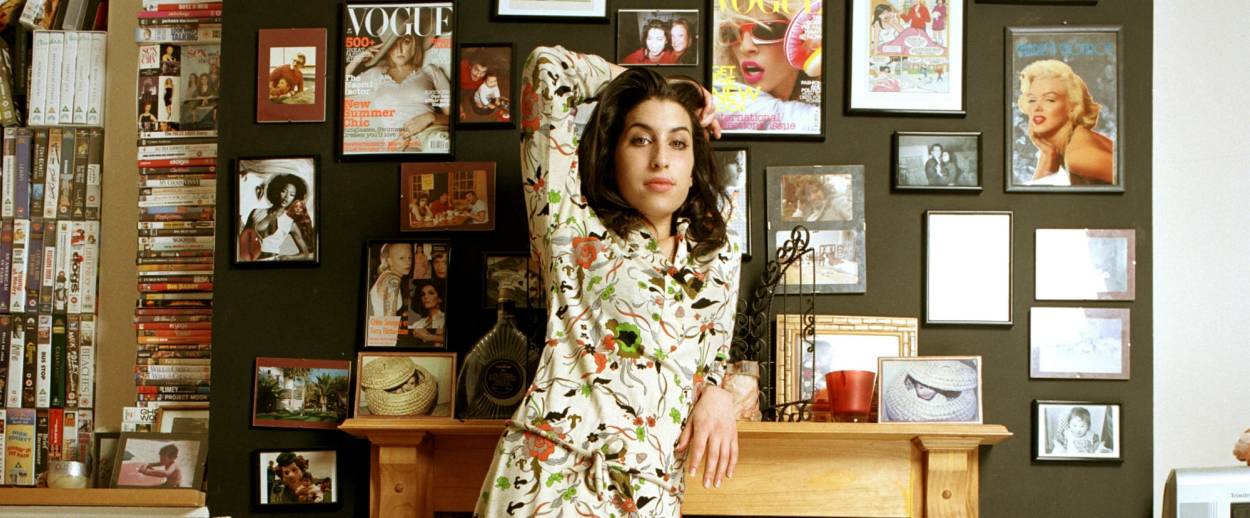Amy Winehouse: A Family Portrait
An exhibit about the late singer’s life opens at the Contemporary Jewish Museum in San Francisco




An exhibition called Amy Winehouse: A Family Portrait opens today at the Contemporary Jewish Museum (CJM) in San Francisco, offering an intimate portrayal of the iconic Jazz singer from the beginning to the troubled end of her life. The display has been transplanted from the Jewish Museum in London, which initially curated the exhibit in close collaboration with the Winehouse family.
In 2013, Tablet contributor Liam Hoare covered the opening in London:
[The exhibit] exposes her roots and provides a window into her family life. It’s “a snapshot of a girl who was, to her deepest core, simply a little Jewish kid from North London with a big talent who, more than anything, just wanted to be true to her heritage,” writes her brother, Alex, in his introduction to the exhibit, which he curated.
The Winehouse family’s heritage in London is traced back to 1890, when patriarch Harris Winehouse arrived in London from Minsk, to be followed by the rest of his family. “He came to London by mistake—he was supposed to be going to New York—but now the thought of us being from anywhere else seems slightly ridiculous.”
His son Ben owned a barbershop in the working-class East End, above which the family lived for fifty years, and his grandson and great-grandson drove hackney carriages. And so did his great-great-grandson, almost. His great-great-granddaughter was Amy.
The exhibit contains traces of the family’s Jewishness. It speaks to their continued attachment to the East End where some of their relatives still live, even though Amy born raised in Southgate, in north London. There’s a photograph of Amy at fifteen wearing her uniform of the Jewish Lads’ and Girls’ Brigade, and one of her brother Alex at his bar mitzvah with parents Mitch and Janis.
Touchingly, there’s a copy of Claudia Roden’s The Book of Jewish Food, which Alex gave Amy for one of her birthdays because she “wanted to learn how to make chicken soup,” although she never did. At least not well, anyway.
[The exhibition] also attempts to convey that, in spite of her early rebelliousness of the sort that got her removed from drama school, Winehouse was above all someone who loved music, was aware of herself and her gifts, and yet revelled in her rise. On display are some of her favorite records by Aretha Franklin and Ray Charles, Frank Sinatra, Tony Bennett, and Carole King. When she was starting out, she kept all the backstage passes and wristbands she received when performing at festivals.
This young woman is almost unrecognizable from the star we saw after Back to Black. The Jewish Museum’s depiction of Amy Winehouse is of someone who was relatively untroubled and almost angelic, if a little cheeky, and yet her demons were scarred into her lyrics and intrinsic to her persona and her decline.
The exhibit, then, leaves a space to question where the one ends and the other begins—how does a “little Jewish kid from North London with a big talent” become a woman with a big talent but with drug problems, a messy personal life, and a career and a life which ended before it could fully blossom? Amy Winehouse: A Family Portrait does not wish to ask this—perhaps that is not its purpose. It might be a little more honest and earnest, though, if it tried.
The exhibit’s opening closely follows the release of the documentary Amy, an archival footage-filled biography of the late singer. Tablet columnist Rachel Shukert commented a couple of weeks ago that the film explores whether Amy’s death was inevitable, or if it could have been prevented:
Yes—and no. That’s the answer [the movie’s director] comes to, through a vast exhibition of home video clips, concert footage, tabloid coverage, and exhaustive interviews with her friends and loved ones.
Amy was willful, she was a drug addict, she was hopelessly, obsessively in love with a man who was absolutely no good for her: But where would she have been if her mother had taken her bulimia more seriously? Or if the tabloids hadn’t hounded her so incessantly? Or if her father, who saw an opportunity in his gifted daughter to grab a small slice of the success that had eluded him as an amateur musician, hadn’t famously told his daughter that she didn’t need to go to rehab because she was fine? Would things have turned out differently? Would the music have been the same?
And Tablet contributor Malina Saval wrote a review of the documentary in which she described the personal resonance watching the younger Amy inspired:
Stripped of sensationalism, Kapadia’s film relies on a bounty of archival footage, much of it shot on cellphones, and interviews with friends and family members, as well as the unsparing confessional lyrics of such tracks as “Tears Dry on Their Own” and “Love Is a Losing Game” to create an introspective and nuanced glimpse into the world of Winehouse, one that hews closer to the truth of who she was as a person, a songwriter, an artist—and even, culturally at least, a Jew. Obviously, Winehouse wasn’t the most observant Jew, but that’s hardly the point. If you’re a Jewish girl—or some quasi grown-up version thereof—watching never-before-seen footage of Winehouse as a shy but sparkly teen, with her dry sense of humor and wall of wavy black hair like that of a biblical heroine, is a revelation, because she reminds you of yourself, or at the very least, someone you knew growing up.
Amy Winehouse: A Family Portrait is on view from July 23–November 1 at the Contemporary Jewish Museum in San Francisco.
Jas Chana is a former intern at Tablet.